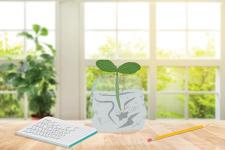Summary
Children will learn how seeds become plants and that plants produce foods for us to eat. They will sprout and grow their own beans and document the process.
Prep time
40 minutes
Activity duration
60 minutes
On this page
- Learning goals
- Materials
- Planning considerations
- Connecting to Canada’s food guide
- Activity instructions
- Optional learning extension
Learning goals
- Practice caring for and growing seeds.
- Discuss how vegetables and fruits grow and which foods grow locally.
Materials
- Tape
- Marker
- Gardening soil
- Food guide snapshot
- How does it grow? cards
- Paper towels, 1 per child
- Small containers, 1 per child
- Spray bottle filled with water
- Resealable plastic bags, 1 per child
- Journals with blank pages, 1 per child
- Garden bean seeds like green or yellow beans, 3 to 4 per child
Planning considerations
- Print the How does it grow? cards.
- Collect seeds and all materials needed to sprout the seeds.
- Make or buy journals with lined pages for each child.
- Research which foods grow in your region and when they are in season.
- Consider that this activity will take place over a few days.
- An additional 5 to 10 minutes of daily care will be needed to moisten the paper towel that is placed with the seed.
- The Engage, Explore and Explain activities can be divided over 3 sessions.
Connecting to Canada’s food guide
- Review Eat vegetables and fruits for your activity planning.
Activity instructions
Engage
- Discuss seeds and plants with the group.
- Explain how plants are important for many reasons, including producing food.
- Discuss how plants develop from seeds. Seeds and plants need water, nutrients and sunlight to grow, be healthy, and produce vegetables and fruits, whole grain foods, and some protein foods (e.g. lentils).
- Explain that many of these foods can be bought in stores or directly from farmers, and some can be grown in our gardens.
- Explain that, similar to plants, humans also need nutrients and water to grow and be healthy. We get these nutrients by eating plant foods or animals.
- Ask:
- Has anyone gardened to produce food before? If yes:
- What types of food did you grow?
- How did you prepare these foods to be eaten?
- What are some foods that grow in our region?
- What times of the year are these local foods available? (e.g., summer, fall)
- What types of meals can be prepared with these foods?
- Has anyone gardened to produce food before? If yes:
- Explore with children how different foods grow using the How does it grow? cards.
- Show the images of foods in the format they are bought or harvested. Ask children, “How does it grow?"
- Once children have volunteered responses, show the answers on the cards that demonstrate how foods grow.
- Be mindful that children have varying access to food, and that it may be difficult for some children to discuss. We encourage you to think about how sensitive this topic may be and to address it with care and compassion.
Explore
- Provide each child with garden bean seeds, a paper towel and re-sealable plastic bags.
- Get children to wet their paper towels until damp, fold in half, and place them in the bag.
- Instruct children to place their seeds on the paper towel in the bag and to write their name on the bag.
- Place the bags near a window that is located in a warm area and that has ample sunlight throughout the day.
- Allow seeds to sprout. This may take 7 to 10 days.
- Instruct children to monitor their beans daily to observe how they progress. Ask children to use their journal to draw their beans’ progress every day.
- Each child must make sure that their paper towel remains damp as the beans sprout. If their towel becomes dry, tell children to remove it from their bags, spray water onto it, and place the sprouts and paper towel back in the bag. Make sure the towels are damp but not wet.
- Once seeds have sprouted and a root has started to emerge, it’s time to plant them. Provide a small container and soil to each child.
- Instruct children to fill their containers with soil and to plant their sprouted seeds.
- Each child can bring their seeds home and continue to water as it grows.
Explain
- Divide children into groups and have them reflect on the following questions:
- What have you learned about growing plants?
- Where do foods, such as green or yellow beans, get grouped within Canada’s food guide?
- What are some recipes that you can make with green or yellow beans?
- What else would you like to eat with green or yellow beans?
- Ask each group to share their answers with the rest of the group.
Optional learning extension
Prepare a bean salad with the children. You can choose any bean recipe that aligns with your group’s budget, access to resources and cooking equipment. One example is Canada’s Food Guide mixed bean salad that children can help you prepare, or you can simply cook the beans and season with balsamic vinegar and olive oil.
Ask children to wash their hands and their workspace. Provide a bowl and utensils to each child who wishes to try the salad. Avoid putting pressure on children to eat the salad. If they do not wish to eat the food, you can invite them to politely decline by saying “No, thank you.” Remember to connect with parents or guardians to identify any concerns about food allergies or dietary restrictions.



